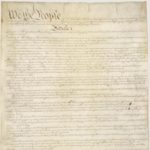After just six years under the Articles of Confederation, a committee of anxious delegates agreed to meet in Philadelphia to amend the government. The country was in an economic crisis — citizens couldn’t pay their debts, the government couldn’t really collect taxes, and rebellions were cropping up in states across the nation. The existing government had the potential to drive the country to ruin. So fifty-five men gathered to determine the shape of the new United States.
The document that emerged after that summer of debate was littered with masterful planning, strange ideas and unsavory concessions. The delegates decided they’d be pleased if this new government lasted fifty years. It has been our blueprint for over two centuries now. This is the story of how our Constitution came to be.
This short episode includes a one-page Graphic Organizer for students to take notes on while listening, as well as discussion questions on the back side.
Constitution Day Scavenger Hunt with 60-Second Civics
Fifty-five delegates attended the Constitutional Convention in Philadelphia in 1787. Most students can identify George Washington or James Madison. But what about the 53 other delegates? Who were they? How did they influence the convention? In this lesson, students will familiarize themselves with the delegates by listening to a series of 60-Second Civics podcast episodes devoted to the Framers of the Constitution.
The Constitutional Convention
In the summer of 1787, delegates gathered for a convention in Philadelphia, with the goal of revising the Articles of Confederation, the nation’s existing governing document, which wasn’t really working. Instead, they wrote a whole new document, which created a revolutionary form of government: the U.S. Constitution. Read more about the summer of 1787 in the National Constitution Center’s learning module.
The Constitutional Convention of 1787
In this unit, students will examine the roles that key American founders played in creating the Constitution, and the challenges they faced in the process. They will learn why many Americans in the 1780s believed that reforms to the Articles of Confederation were necessary, and the steps taken to authorize the 1787 Convention in Philadelphia. They will become familiar with the main issues that divided delegates at the Convention, particularly the questions of representation in Congress and the office of the presidency. Finally, they will see how a spirit of compromise, in the end, was necessary for the Convention to fulfill its task of improving the American political system.
“Father” of Our Country v. “Father” of the Bill of Rights
At the Constitutional Convention in Philadelphia, delegates analyzed, argued, and debated the new Constitution. George Mason, a Virginian, pleaded with the fifty-five delegates for the inclusion of a list of guaranteed rights. Mason (sometimes referred to as the “father of the Bill of Rights”) wanted the new Constitution to guarantee freedom of speech, press, and religion, and the right to a fair jury trial. He also wanted to include the freedom to vote.
The Constitutional Convention: Lesson 3: Creating the Office of the Presidency

This lesson focuses on the arguments over the various characteristics and powers of the office of president as debated at Constitutional Convention of 1787. By examining the views of delegates as recorded in James Madison’s Notes of Debates in the Federal Convention of 1787, students will understand the arguments of those who supported either a strong, independent executive, or a very limited and highly controlled executive. Students will also see why, in the end, the delegates compromised.
Ratifying the Constitution

This lesson introduces students to the vigorous debates between the Federalist and the Anti-Federalists surrounding the ratification of the Constitution that took place in the state conventions.
In the state ratification conventions, delegates argued the wisdom of adopting the Constitution. Elected specifically to serve in these conventions, they came from a range of backgrounds, from the very elite and highly educated, to those of humbler birth and station. State delegates grappled with questions about the nature of democracy, the distribution of wealth and power in society, the rights of individuals and minority groups, and the role of dissent in a republic.
Should the Electoral College Be Reformed?
This deliberation has students view C-SPAN video clips to learn about the history and Constitutional background of the Electoral College. Students will also explore arguments for and against reforming the Electoral College. Using this information, students will develop and argue their position on the question: Should the Electoral College Be Reformed?
The Influence of the Declaration of Independence on the Constitution
In this lesson, students will use C-SPAN video clips to examine the founding principles that emerged from the Constitutional Convention as well as hear about some of the people who participated. Students will use this information to analyze the role the compromise played in the creation of the Constitution.
The Constitutional Convention
In this lesson, students will use C-SPAN video clips to examine the founding principles that emerged from the Constitutional Convention as well as hear about some of the people who participated. Students will use this information to analyze the role the compromise played in the creation of the Constitution.